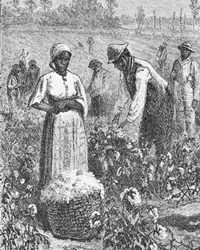- Lesson Plan (104)
- Field Trips (27)
- Distance Learning (16)
- Student Activities (13)
- Primary Sources (8)
- Teacher Reference Materials (6)
- Guest Speakers (5)
- Traveling Trunk (3)
- Other Education Materials (2)
- Media for Loan (1)
- Teacher Workshops & Other Programs (1)
- Salem Maritime National Historic Site (16)
- Fort Scott National Historic Site (13)
- New Orleans Jazz National Historical Park (13)
- First State National Historical Park (9)
- Harriet Tubman Underground Railroad National Historical Park (7)
- Carl Sandburg Home National Historic Site (5)
- Blackstone River Valley National Historical Park (4)
- Booker T Washington National Monument (4)
- George Washington Carver National Monument (4)
- Show More ...
- Social Studies (155)
- Literacy and Language Arts (59)
- Science (19)
- Math (7)
- 9-10.RH.2 (32)
- 9-10.RH.1 (30)
- 6-8.RH.2 (26)
- 9-10.RH.4 (24)
- 9-10.RH.9 (23)
- 9-10.RH.10 (22)
- 6-8.RH.4 (21)
- 6-8.RH.7 (21)
- 11-12.RH.2 (19)
- Show More ...
Showing 171 results for MODERN SLAVERY ...
Slavery on Trial
Slaves as Property
- Type: Primary Sources
- Grade Levels: Middle School: Sixth Grade through Eighth Grade
Students will read a "Reward Flyer" advertising the escape of a Florida slave. This will spark learning about slavery, property, and the Underground Railroad.
MO Outdoor Rangers
- Type: Student Activities ... Other Education Materials
- Grade Levels: Upper Elementary: Third Grade through Fifth Grade
- Type: Lesson Plan
- Grade Levels: Middle School: Sixth Grade through Eighth Grade
What was life and work like for enslaved people on Southern plantations?
Slavery & the Declaration of Independence
- Type: Primary Sources ... Student Activities
- Grade Levels: High School: Ninth Grade through Twelfth Grade
Salem, Slavery, and the Sacred Cod
Exploring the History of Slavery in St. Louis
- Type: Distance Learning
- Grade Levels: Upper Elementary: Third Grade through Fifth Grade

This Distance Learning Program aims to provide an introduction to the history of slavery in St. Louis. Geared for students in grades 3 through 5, the program examines what life was like for enslaved Missourians and highlights the stories of six enslaved African Americans from St. Louis who went on to become nationally famous for their efforts to end slavery and promote racial equality in the United States.
After Appomattox: Artifacts of Slavery and Freedom
- Type: Distance Learning
- Grade Levels: Upper Elementary: Third Grade through Fifth Grade
Lesson 6 - RESEARCHING CONTEMPORARY SLAVERY
- Type: Lesson Plan
- Grade Levels: High School: Ninth Grade through Twelfth Grade
Slavery Systems in America, a classroom lesson
Slatersville, Slave Cloth, and the Slater Fund
- Type: Lesson Plan
- Grade Levels: High School: Ninth Grade through Twelfth Grade

One member of the Slater family, John Fox Slater, became an outspoken abolitionist and gave a considerable amount of his fortune to a fund that paid for schools and the education of Black leaders. A historian in this series asks: “Why did he do it?” Consider this question and the interconnectedness of the economies in the North and the South as you complete the activities in this lesson plan.
Incident at Harpers Ferry: Slavery and John Brown
- Type: Lesson Plan
- Grade Levels: Middle School: Sixth Grade through Eighth Grade
In this lesson, students will share their thoughts on slavery, examine how our country dealt with this institution, consider how both pro-slavery elements and abolitionists looked at slavery and why, and learn a little about John Brown’s early life - in particular, his activities out in Kansas in the years 1855 – 1857. Students will then be able to answer the following essential question: What was slavery like in the antebellum United States?
The Liberty Bell as a Modern Symbol, grades 3-5
The Liberty Bell as a Modern Symbol, grades K-2
How Most of the Plantation Lived: Slavery at the Washington's Farm
- Type: Other Education Materials
- Grade Levels: Upper Elementary: Third Grade through Fifth Grade
- Type: Lesson Plan
- Grade Levels: Middle School: Sixth Grade through Eighth Grade
This lesson is based on the National Register of Historic Places registration files for Wye House, Nathan and Polly Johnson House (and photographs), and Frederick Douglass National Historic Site (and photographs), as well as other source materials on the life of Frederick Douglass.
How did slavery connect Salem to a global economy?
- Type: Primary Sources ... Student Activities ... Teacher Reference Materials
- Grade Levels: High School: Ninth Grade through Twelfth Grade
Family Matters: The Life of a Slave Family Pre-Visit Activity
- Type: Field Trips
- Grade Levels: Middle School: Sixth Grade through Eighth Grade

Family was central to Harriet Tubman's life. As she wrote, "I was free; but there was no one to welcome me to the land of freedom. I was a stranger in a strange land; and my home, after all, was down in Maryland; because my father, my mother, my brothers, and sisters, and friends were there. But I was free, and they should be free." What compelled Tubman to return for her loved ones on multiple trips to guide them to freedom?
How did the slavery economy contribute to the American Revolution in Salem?
- Type: Primary Sources ... Student Activities ... Teacher Reference Materials
- Grade Levels: High School: Ninth Grade through Twelfth Grade













